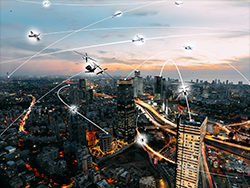Some Companies Still Developing Hydrogen Fuel Cells for VTOL Aircraft Written 17 April 2020

Artist’s rendition of an Urban Air Mobility environment | NASA
Aviation Today reports that “almost all players in the emerging urban air mobility industry have converged on the idea of using fully-electric aircraft, powered by lithium-ion batteries, to create affordable aerial transit options for relatively short distances. But a few companies continue to develop and advocate for the use of hydrogen fuel cells in VTOL [vertical take-off and landing] aircraft, maintaining they hold innate advantages over lithium-ion batteries – primarily in energy density and lifespan – and are the superior choice.” Hypoint is one example of a company looking to develop hydrogen fuel cells, and the company “has demonstrated an air-cooled hydrogen fuel cell powertrain that produces 1000 watts per kilogram of specific power with an energy density of 530 watt-hours per kg.” Meanwhile, Uber, “one of the most notable players in the urban air mobility space and author of the seminal Elevate white paper, has extensively studied hydrogen, hybrid-electric and other possibilities, arriving at a firm conclusion that battery-electric is the best option for UAM. None of Uber’s eight publicly confirmed vehicle partners use hydrogen as a power source.” Batteries and “fuel cells may both have economical applications in aerospace, similar to their evolving role in ground-based transportation. But for the moment, the coming generation of VTOL aircraft for urban air mobility will likely be fully-electric and powered by batteries.”
Full Story (Aviation Today)
